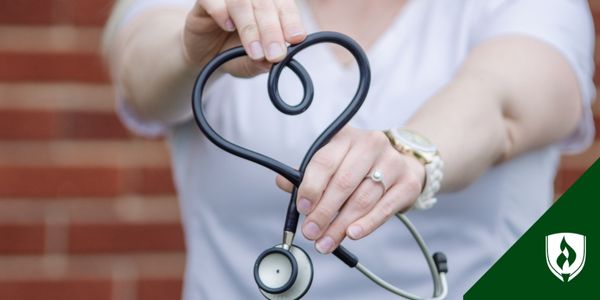What Does an LPN Do? A Closer Look at These Versatile Caregivers
05/22/2025

If you've heard plenty about nursing shortages1 and are seriously considering stepping up to help meet the growing demand for healthcare workers, you know there's a lot of information to explore before deciding which nursing path is right for you.
By now you know that a career in nursing would be a great fit2 for you, but you're hesitant to spend the multiple years in school needed to become a registered nurse. You want to be out on the floor making an impact in your life—and patients' lives—as soon as possible.
What many people new to the nursing field might not know is that there are actually many paths to becoming a nurse3. One long-standing, popular track you may have seen is to become an LPN.
While that option has caught your interest, you need to learn more about this role before deciding if this is the right route for you. We're here to help you understand the duties that fall under the LPN job description and what you'll need to do to become an LPN.
Understanding the Licensed Practical Nursing Role
First off, let's start with the basics. LPN stands for licensed practical nurse. This is a category of licensed nurse that differs from registered nurses. In some states, you may find this role is referred to as a licensed vocational nurse4 (LVN). While the labels are different, LPNs and LVNs are essentially the same.
Now that you've got the name sorted out, you're probably curious about what a licensed practical nurse does in their daily work. The LPN job description covers quite a bit, so let's take a closer look.
At its most basic explanation, licensed practical nurses provide routine care for the sick or injured. They work in conjunction with RNs and physicians to adhere to a care plan for each patient. RNs typically have a wider scope of practice—such as interacting with doctors and administering medication through IVs. While the details will depend on the setting they work in, LPNs typically care for several patients over the course of their shift and must manage their time well to ensure patient care plans stay on track. Curious to read more about "What is an LPN Degree?"4 Read more in our article here.
Common Licensed Practical Nursing Duties
While a licensed practical nurse’s scope of practice may be smaller than that of a registered nurse, there are still plenty of important nursing duties on their plates. The Bureau of Labor Statistics (BLS) notes6 that LPNs are responsible for a range of patient care and administrative tasks, including:
- Monitoring basic patient health such as vital signs and overall condition
- Changing dressings or inserting catheters
- Taking patient histories and maintaining documentation
- Assisting with tests or procedures
- Providing personal care, such as helping with bathing and toileting
- Consulting with RNs on care plans
LPN duties do vary somewhat by state and employer, but you can expect to be providing hands-on patient care regardless of your location or employer.
Types of Jobs and Settings for Licensed Practical Nurses
While the word “nurse” might make some immediately think of hospitals, licensed practical nurses provide care in a variety of settings—even including patients' homes!
Here are a few of the most common places LPNs work and the basic duties they perform:
- Nursing homes: According to the BLS7, 35% of all LPNs work in a nursing care facility. In this setting, LPNs are responsible for the day-to-day care of patients. This includes monitoring medication, assisting with personal hygiene, feeding patients, and watching for changes in overall health.
- Home health care: LPNs work in home health settings under the direction of a physician or RN. They provide bedside care to sick, injured, or disabled patients. This care includes monitoring vital signs, giving injections, dressing wounds, and assisting with daily activities in patients' homes. The demand for LPNs in home health care has grown substantially since the COVID-19 pandemic, driven by more patients opting for in-home care due to comfort and safety concerns.
- Hospitals: Some LPNs do work in hospitals assisting RNs. They perform basic medical procedures such as checking vital signs, passing medication and may also supervise nursing assistants8.
- Physician offices: Depending on the type of clinic, LPN duties in outpatient doctor's offices can include everything from wound care to giving immunizations. They work with all ages and report directly to a physician.
- Military: For LPNs who want more excitement, joining the military provides the opportunity to gain experience in an extremely fast-paced setting. LPNs may enlist as medics and assist with emergency care on and off the battlefield.
- Correctional facilities: This unique setting requires LPNs to understand the sociological and psychological aspects of treating incarcerated patients. These nurses typically provide both routine illness and emergency care.
- Travel: Adventure-seeking LPNs who have more than a year of clinical experience have the option to become a travel nurse. This allows nurses to travel and work in different hospitals across the country for shorter periods of time. Travel LPN duties will be very similar to nurses in other settings.
- Rehabilitation centers: In this setting, LPNs work on a team to provide therapeutic care to those recovering from trauma, injury, illness, and more.
Benefits of Becoming a Licensed practical nurse
Let's take a closer look at what makes this nursing career path an appealing option. For starters, the potential 12-month time frame for earning a Practical Nursing Diploma9 is often a deciding factor for those considering LPN careers versus longer Registered Nursing (RN) degree programs.
Another appealing factor is the job outlook10 for LPNs. According to the BLS11, employment of LPNs is projected to increase 3% by 2033. This demand is largely driven by the aging Baby Boomer generation, who are now entering their senior years and require more healthcare services.
While measurable factors like time in school and salary are a big draw, that's just part of the picture. LPNs, particularly those who work in elder care, spend their workday helping some of the most vulnerable people in our lives and can build strong bonds with them along the way.
“Nurses working in long-term care spend an extended amount of time with their patients, allowing them to develop lasting and valuable relationships,” says Kenny Kadar, president of Coast Medical Service12. “The opportunity to form long-term relationships with your patients is rare in the nursing field, making long-term care unique in this privilege.”
Becoming a licensed practical nurse provides an achievable entry point into the healthcare field—one that can span an entire career or leave room for progressing into more advanced nursing roles. For those who choose to continue advancing their nursing education, there are LPN-to-RN bridge programs13 that make it convenient to do so.
How the Role Changed After the COVID-19 Pandemic
The role of LPNs has seen significant evolution since 2020, especially in response to the COVID-19 pandemic14. LPNs played a critical role in pandemic response efforts, including assisting with COVID-19 testing and vaccine administration.
In many settings, licensed practical nurses are now expected to be proficient in using technology like electronic health records (EHRs), telemedicine, and patient monitoring systems, which have become essential in modern healthcare.
The scope of practice for LPNs has expanded in some states, allowing them to take on more responsibilities, such as administering certain medications and assisting in more complex procedures under supervision.
For example, in states like Ohio, licensed practical nurses can now perform certain IV therapy procedures15, such as administering medications after a registered nurse initiates the infusion.
Launch Your License Practical Nurse LPN Career
Now that you understand what an LPN does and the rewarding opportunities in this field, consider how you can begin your journey. Whether you're seeking a quick path into healthcare or looking to explore nursing before committing to an RN role, becoming an LPN could be your ideal next step. Ready to explore further? Sign up for a Nursing Information Session today.
Related Articles:
- LPN vs. CNA: Comparing Potential First Steps into the Nursing Field
- What Is a Practical Nurse? Understanding the Important Work of LPNs
1Mojtaba Vaismoradi, "Addressing Nurse Shortages and Pandemic Responses to Enhance Patient Safety Within Global Health Challenges," at https://www.researchgate.net/profile/Mojtaba-Vaismoradi/publication/389127470_Addressing_Nurse_Shortages_and_Pandemic_Responses_to_Enhance_Patient_Safety_Within_Global_Health_Challenges/links/67b5c6c34c479b26c9e64ba8/Addressing-Nurse-Shortages-and-Pandemic-Responses-to-Enhance-Patient-Safety-Within-Global-Health-Challenges.pdf (visited Mar. 25, 2025).
2Rasmussen University, “Different Levels of Nursing,” at https://www.rasmussen.edu/degrees/nursing/blog/different-levels-of-nursing/ (visited Mar. 25, 2025).
3Rasmussen University, “LVN vs. LPN: What’s the Difference?”, at https://www.rasmussen.edu/degrees/nursing/blog/lvn-vs-lpn/ (visited Mar. 25, 2025).
4Rasmussen University, “What Is an LPN Degree?”, at https://www.rasmussen.edu/degrees/nursing/blog/what-is-an-lpn-degree/ (visited Mar. 25, 2025).
5Bureau of Labor Statistics, U.S. Department of Labor, Occupational Outlook Handbook, Licensed Practical and Licensed Vocational Nurses, at https://www.bls.gov/ooh/healthcare/licensed-practical-and-licensed-vocational-nurses.htm#tab-2 (visited Mar. 25, 2025).
6Bureau of Labor Statistics, U.S. Department of Labor, Occupational Outlook Handbook, Licensed Practical and Licensed Vocational Nurses, at https://www.bls.gov/ooh/healthcare/licensed-practical-and-licensed-vocational-nurses.htm#tab-3 (visited Mar. 25, 2025).
7Rasmussen University, “What Is a CNA?”, at https://www.rasmussen.edu/degrees/nursing/blog/what-is-a-cna/ (visited Mar. 25, 2025).
8Rasmussen University, “Practical Nursing Program,” at https://www.rasmussen.edu/degrees/nursing/practical-nursing/ (visited Mar. 25, 2025).
9Rasmussen University, “Why LPNs Are in Demand,” at https://www.rasmussen.edu/degrees/nursing/blog/why-lpns-are-in-demand/ (visited Mar. 25, 2025).
10Bureau of Labor Statistics, U.S. Department of Labor, Occupational Outlook Handbook, Licensed Practical and Licensed Vocational Nurses, at https://www.bls.gov/ooh/healthcare/licensed-practical-and-licensed-vocational-nurses.htm#tab-6 (visited Mar. 25, 2025).
11Coast Medical Service, at https://coastmedicalservice.com/ (visited Mar. 25, 2025).
12Rasmussen University, “Choosing an LPN to RN Program,” at https://www.rasmussen.edu/degrees/nursing/blog/choosing-an-lpn-to-rn-program/ (visited Mar. 25, 2025).
13Lippincott NursingCenter, “Renewing the Care Team Model: Leveraging the LPN Role,” at https://journals.lww.com/nursingmanagement/fulltext/2023/01000/renewing_the_care_team_model__leveraging_the_lpn.5.aspx (visited Mar. 25, 2025).
14Ohio Revised Code, Section 4723.18, at https://codes.ohio.gov/ohio-revised-code/section-4723.18 (visited Mar. 25, 2025).
15Rasmussen University, “LPN vs. RN: Advantages of Being a Registered Nurse,” at https://www.rasmussen.edu/degrees/nursing/blog/lpn-vs-rn-advantages-of-being-registered-nurse/ (visited Mar. 25, 2025).
16Rasmussen University, “Guide to Working in a Nursing Home,” at https://www.rasmussen.edu/degrees/nursing/blog/guide-to-working-in-a-nursing-home/ (visited Mar. 25, 2025).
17Rasmussen University, “Nursing Session Information Form,” at https://www.rasmussen.edu/nursing-session-form/ (visited Mar. 25, 2025).
18Lippincott NursingCenter, “Addressing Nurse Shortages and Pandemic Responses to Enhance Patient Safety Within Global Health Challenges,” at https://journals.lww.com/nursingmanagement/fulltext/2023/01000/renewing_the_care_team_model__leveraging_the_lpn.5.aspx (visited Mar. 25, 2025).
Time to completion is dependent on number of transfer credits accepted and the number of courses completed each term.
EDITOR'S NOTE: This article was originally published in July 2014 and 2021. It has since been updated to include information relevant to 2025.



